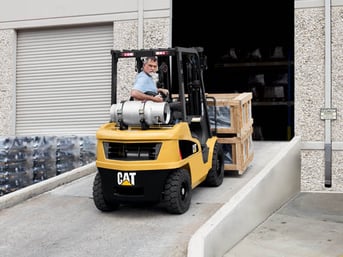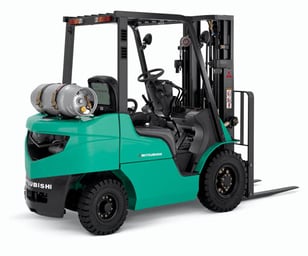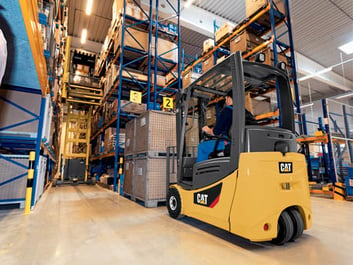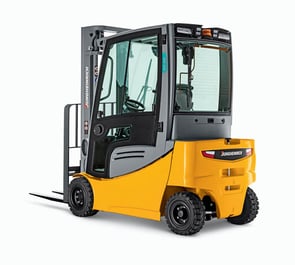Selecting what forklift to use is an extremely important decision for any company that deals with material handling as the ideal forklift will save both time and money. However, there is not a standard solution to everyone’s problem because every work environment and application is different. This is why knowing the pros, cons, and application of electric vs internal combustion forklifts is particularly important. This article will assist you in learning which option would best suit your business.
Internal Combustion Forklifts

CAT Internal Combustion Forklift

Mitsubishi Internal Combustion Forklift
Internal Combustion (IC) is the more traditional form of lift truck, being fueled by a replaceable and refillable Liquefied Petroleum (LP) tank. A key advantage of an IC forklift is how easy it is to refill, done simply by loading a new or refilling the old gas tank. This process can take as little as a couple of minutes. In terms of performance, IC forklifts are generally utilized in heavier-duty applications where larger capacity is required to move the load. Below are some pros and cons of using an IC propane forklift compared to the electric alternative:
Pros:
- Lower initial cost
- Better for long runs
- More power when using at high speeds and going up ramps
- Capacity of over 35,000 lbs.
- Easy to refuel
- Ideal for outdoor use
Cons:
- More maintenance and inspections required
- Higher fueling cost
- Good ventilation required for indoor usage
Electric Forklifts

Cat Electric Forklift

Jungheinrich Electric Forklift
Electric lift trucks are battery powered machines and traditionally are outdone by IC in terms of capacity. However, advances in engineering are resulting in more power and utilization of outdoor applications. A key advantage of using electric forklifts is the significant fuel cost savings over time. In addition, there are less moving parts in the engine, requiring less overall maintenance and lowering costs. The biggest consideration of an electric forklift is the process of recharging the battery, which takes 8 hours to recharge completely and 8 hours to cool down before using. It is common in an operation with multiple shifts to purchase additional batteries to decrease downtime. The duration of a single charge depends on the application but can be anywhere from 3 hours with older batteries to 16 hours with the 2 Shifts 1 Charge Guarantee from Jungeinrich.
Below are some pros and cons of using an electric forklift compared to the IC alternative:
Pros:
- Zero emissions produced
- Reduction of maintenance costs
- Decreased noise levels when running
- Decreased fueling cost
- Economic life is longer
- Decreased aisle width requirements
Cons:
- Must have a battery charging station
- Additional training for battery maintenance
- Limited availability over 15,000 lbs.
- Higher initial cost when purchasing
In conclusion, finding the perfect forklift for your operation depends on several different factors. To learn more about the differences between electric and IC forklifts, as well as which best fits your operation’s application contact your local territory manager today.